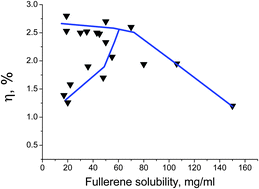Material solubility and molecular compatibility effects in the design of fullerene/polymer composites for organic bulk heterojunction solar cells†
Abstract
We report a systematic study of more than 100 bicomponent systems composed of 19 different

* Corresponding authors
a
Institute for Problems of Chemical Physics of Russian Academy of Sciences, Semenov Prospect 1, Chernogolovka, Moscow region, Russia
E-mail:
troshin2003@inbox.ru
b Enikolopov Institute of Synthetic Polymeric Materials, Russian Academy of Sciences, 70 ul. Profsoyuznaya, 117393 Moscow, Russia
c Linz Institute for Organic Solar Cells (LIOS), Johannes Kepler University Linz, Altenbergerstrasse 69, A-4040 Linz, Austria
We report a systematic study of more than 100 bicomponent systems composed of 19 different

 Please wait while we load your content...
Something went wrong. Try again?
Please wait while we load your content...
Something went wrong. Try again?
P. A. Troshin, D. K. Susarova, E. A. Khakina, A. A. Goryachev, O. V. Borshchev, S. A. Ponomarenko, V. F. Razumov and N. S. Sariciftci, J. Mater. Chem., 2012, 22, 18433 DOI: 10.1039/C2JM32873A
To request permission to reproduce material from this article, please go to the Copyright Clearance Center request page.
If you are an author contributing to an RSC publication, you do not need to request permission provided correct acknowledgement is given.
If you are the author of this article, you do not need to request permission to reproduce figures and diagrams provided correct acknowledgement is given. If you want to reproduce the whole article in a third-party publication (excluding your thesis/dissertation for which permission is not required) please go to the Copyright Clearance Center request page.
Read more about how to correctly acknowledge RSC content.
 Fetching data from CrossRef.
Fetching data from CrossRef.
This may take some time to load.
Loading related content
